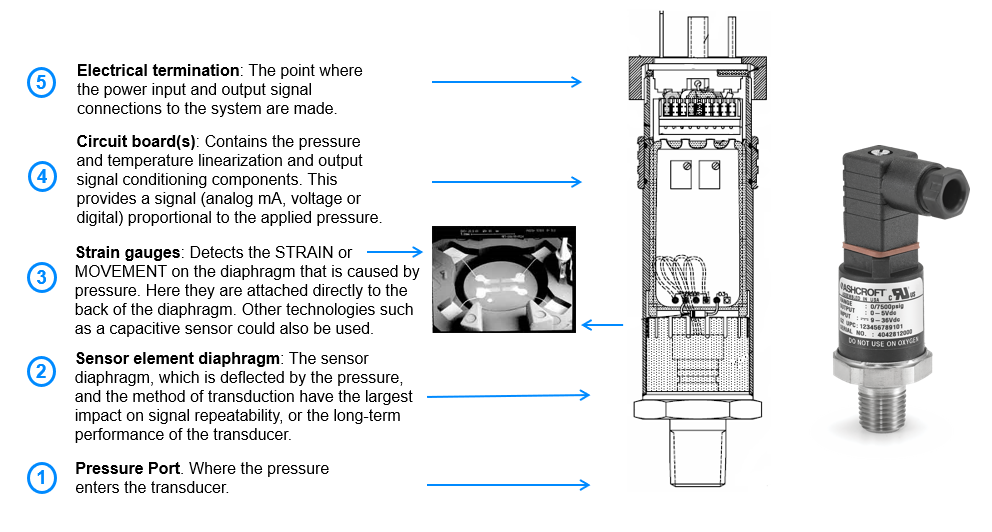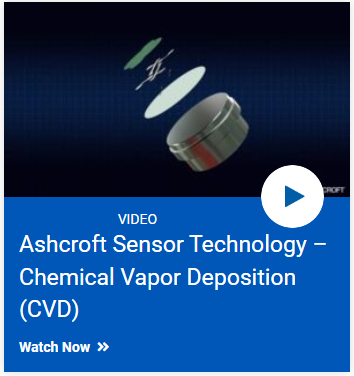
By:
Mark Zabawa
Director of North America OEM/Direct Sales
Published on:
December 18th, 2023
Subscribe now and get the latest blog posts delivered straight to your inbox.
What Makes OEM Pressure Sensors Accurate and Repeatable?

By:
Mark Zabawa
Director of North America OEM/Direct Sales
Published on:
December 18th, 2023

What do race cars, off-highway vehicles (OHV) and any other high-performance machine or system have in common? They are only as good as the instruments you find under the hood. In fact, something as small as the pressure sensing device can have a big impact on the success or failure of meeting your equipment’s operational expectations.
As an equipment builder, you expect your OEM pressure measurement instruments to be accurate. That’s a given. But even if it’s not top of mind immediately, what you want even more than accuracy is long-term repeatability.
Ashcroft has been manufacturing pressure measurement instrumentation since 1852. So, we understand how challenging it can be to find high-quality, accurate and cost-effective instruments that go the distance to deliver consistent performance over the long term. This is especially relevant for sensors used in tough conditions involving exposure to wide temperature ranges, high cycle life expectations and vibration. Each of these could affect the accuracy and repeatability of critical pressure measurements.
This article will explain the elements of an OEM pressure sensor, clarify the difference between repeatability and accuracy, and show you what makes a sensor accurate and repeatable over time. When you are done reading, you will know the key factors to look for when purchasing a high-performance pressure sensor for demanding cycle life conditions which can be common to many applications.
Why accuracy and repeatability are so important.
Your equipment endures a range of challenging conditions, and you depend on your sensors to let you know when something is wrong. That’s why it is crucial to incorporate pressure sensors that can withstand wide-ranging conditions and continue to function reliably over an extended period. The single most important factor when selecting a pressure sensor is the instrument’s ability to achieve and maintain a desired level of accuracy throughout your equipment’s expected operating timeframe and environmental conditions.
Key elements of typical OEM pressure sensors.
Sensors like the Ashcroft G2 Pressure Transducer and S1 Pressure Transducer are two examples of instruments specifically designed to measure and monitor high-pressure levels in original equipment manufacturing (OEM) and applications as well as in industrial processes.
Here’s a look at some of the key elements of an OEM pressure sensor and their purpose:
Figure 1: OEM pressure sensor elements.

What is the definition of accuracy and repeatability?
Accuracy and repeatability are both important characteristics to consider when selecting a pressure-measuring instrument, especially in applications where long-term equipment performance is required without sensor adjustment.
The accuracy of your sensor is in effect expressed by its inaccuracy. In other words, how much does the desired value of a specific pressure deviate from the acceptable error of that measurement? This acceptable error is computed as a percentage of the measured output of the sensor compared to the ideal output. This is expressed as a percentage of the sensor's pressure range span.
For your reference, here are commonly referenced accuracy statements:  Accuracy is a result of the production calibration process which will linearize the output signal to achieve the desired manufacturer’s performance.
Accuracy is a result of the production calibration process which will linearize the output signal to achieve the desired manufacturer’s performance.
Repeatability is inherent in the design, material and production techniques used in making the sensor, and cannot be derived or controlled during the calibration process. However, it is the key determining factor in the finished pressure sensor’s precision and long-term measurement consistency. A pressure sensor incorporating a high repeatability sensor element will ensure stable system performance over an extended timeframe without any form of recalibration or re-zero.
What is included in an accuracy statement?
Multiple elements contribute to an overall accuracy or sensor performance statement. Although there are generally no industry standards, the following are the most commonly stated elements and account for the majority (if not all) of the potential sensor inaccuracy. They are typically expressed as % of Full Scale or Span:
- Nonlinearity error: The deviation between the linear trend line of an instrument and its ideal output line.\
- Hysteresis error: The deviation in the instrument's output when pressure is increased compared to when it is decreased.
- Non-repeatability error: The maximum deviation for any given pressure reading over the calibrated pressure range after a defined # of cycles, often 3-5 cycles. The non-repeatability error is arguably the least appreciated or understood, but in many cases is the most important. This is particularly true when taking into account expectations for performance over time, which is typically stated as stability.
- Zero offset error: The deviation from actual versus ideal reading at zero pressure.
- Span setting error: The deviation from actual versus ideal reading for span pressure (the difference from zero to full-scale pressure reading).
- Zero and span temperature coefficient error: This error represents the maximum deviation in zero and span offset output as the temperature varies from the ambient calibrated setting to any other temperature within the specified calibrated range.
Sensor element technology: the primary factor contributing to pressure sensor repeatability.
When choosing a sensor for your pressure application, accuracy statements can vary among the different pressure instrument manufacturers. So, the best indicator in determining the instruments’ long-term performance starts with the sensing technology.
Pressure sensors incorporate various sensing technologies such as bonded strain gauges, piezoresistive, capacitive or piezoelectric elements. Each technology incorporates its own repeatability characteristics. Depending upon the application, sensor cycling/life expectations, external factors such as vibration, temperature, etc. the sensing technology may make the difference in meeting or exceeding the OEM’s product performance expectations.
Chemical Vapor Deposition (CVD) technology
This high-tech sensing element is a great example of the advanced technology used in high-accuracy pressure sensors. It is designed to maintain high reliability and performance across all mid to high-pressure applications. Ashcroft pressure transducers, including the S1 OEM pressure sensor, the G2 and our high-purity ZT and ZX pressure transmitters, all use CVD sensing technology to achieve precise and consistent pressure measuring. Watch this video to learn more.
Here are a few of the other factors to look for when accuracy is important:
1. Calibration: When it is important to reduce time spent addressing zero and span offset errors in production or field installation, review accuracy statements to verify the inclusion of the zero and span offset errors. And, when you want to avoid costly field recalibration activities, review repeatability or stability statements or sensing element details versus application demands.
2. Construction: Wetted materials must meet the necessary long-term compatibility requirements of the application. High-pressure applications, particularly high cycle life, may benefit from a welded sensor construction vs an o-ring seal.
3. Temperature: The sensor accuracy statement should provide a clear specification statement over the necessary application temperature range. Many OEM applications require repeatable, stable, performance over a wide operating temperature range.
4. Signal conditioning: This circuitry is designed to amplify, filter, and linearize the sensor's output signal, which minimizes signal distortions and noise to help improve accuracy. This can be particularly important in high-noise, high-EMC environments.
5. Environmental protection: The ingress protection (IP) rating of the sensor needs to meet the requirements of the application. Depending upon sensor life expectancy, whether mating cables are involved (and whether they are removed in the field) and actual water exposure, the sensor housing could be a factor in meeting sensor life expectancy. In particular, if “venting” for proper gauge pressure measurement is required, the design of the vent in the sensor housing is critical.
6. Pressure Range and Resolution. In many applications, there is a balance to achieve optimum output signal resolution while ensuring that the sensor can withstand the maximum operating pressure conditions at a high number of pressure cycles. The sensing technology choice may have a big impact on both the usefulness of the output resolution in the form of high repeatability while also directly contributing to whether the sensor can withstand the operating pressure conditions. This could be particularly meaningful in challenging fluid-based applications given the added factor of hydraulic hammer effects.
There’s so much more to learn about pressure sensor accuracy.
Now that you understand what makes high-pressure sensors accurate and repeatable, you can research the solution that’s best for your application. Keep these factors in mind to help ensure you avoid problems and keep your system or equipment running safely and efficiently. Take a look at these other resources and contact us with questions.
- Choosing the Right Pressure Sensor: 5 Factors to Consider
- Choosing a Pressure Transducer for Critical Environments
- How Does Media Temperature Affect Pressure Transducer Performance?
- How to Protect and Optimize Pressure Transducers on Mobile Hydraulics
- How Much Do Pressure Transducers Cost? (6 Factors Impacting Price)
Feel free to contact us today to talk to one of our industry experts and get your questions answered.
And if you’d like to learn more about the accuracy of your pressure instruments, download our eBook:
Mark Zabawa, Director of North America OEM/Direct Sales
Mark Zabawa is the Director of North America OEM/Direct Sales here at Ashcroft. He has spent the past 25+ years in the pressure sensor/transducer industry, with 15 of those years at Ashcroft. Mark has been in roles ranging from Technical Support and Product Management to Regional and National Sales, and his current role is focused on OEM Direct Sales.



























